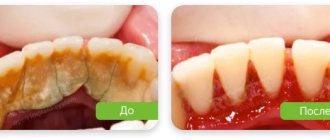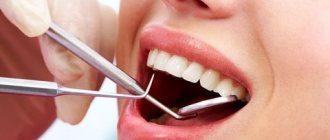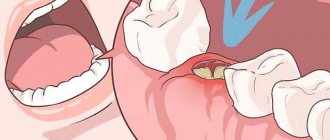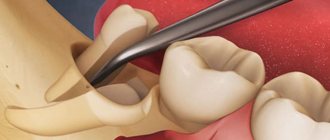The causes of inflammatory processes and diseases of teeth and gums are common mistakes: neglect of oral hygiene, bad habits, irregular visits to the dentist. Almost always, the patient comes to the doctor not for advice, but to eliminate an existing problem. Pain during root canal treatment occurs when teeth are deeply damaged by an infection. To save the tooth, the doctor cleans and treats the canals. In this case, the nerves and pulp are removed, and the resulting cavity is filled with special compounds. At the end of the procedure, the healed tooth should no longer bother you, but pain often appears again.
Indications for root canal treatment in permanent teeth:
- acute and aggravated pulpitis;
- chronic pulpitis;
- caries of enamel and dentin (medium and deep stages);
- acute and aggravated periodontitis;
- chronic forms of periodontitis;
- tooth trauma with opening of the cavity and exposure of the nerve [1].
Filling can be carried out as planned, when the patient himself comes to the doctor as damage is detected, or as an emergency, as a result of acute pain.
Successful restoration of tooth shape and function with composites requires strict adherence to a number of steps:
- Preparing the patient for restoration. The dentist assesses the degree of tooth destruction, the condition of the periapical tissues, functional load, and the need to use an intracanal pin.
- Preparing the tooth for restoration. The doctor selects the colors of the restoration and removes tooth formations.
- Preparation of a carious cavity. The dentist selects a filling material, opens the enamel prisms, isolates the tooth from saliva, drys the cavity, applies a medical lining (if necessary), creates a hybrid layer from a moisture-resistant adhesive substance, applies the adhesive, introduces a composite material into the cavity, modeling the filling and final highlighting.
The criterion for a high-quality restoration is compliance with the shape of the tooth, the absence of overhanging edges of the filling, and the transition between the filling and the tooth tissue does not have a noticeable boundary.
“As the results of clinical trials have shown, endodontic manipulations in one root canal take from 40 minutes to 2 hours, depending on the condition of the canal.
Most of the time is spent on its mechanical processing. Filling one canal using the lateral condensation method without correction of the working length requires an average of 12 minutes Lutskaya I.K., Doctor of Medical Sciences, Professor, Head of the Department of Therapeutic Dentistry of the Belarusian Medical Academy of Postgraduate Education [2]
Causes of pain during root canal treatment
The most common and most unpleasant complication of endodontic treatment for patients is pain after filling the root canals of a tooth. This is not always considered a pathology, since during the first 7 days the persistence of a slight aching soreness is normal and may be an individual reaction of the body. Severe pain indicates that treatment has not been successful. The reason for this may be:
- non-compliance with pulpitis treatment techniques;
- perforation of the tooth root;
- overestimation of the filling during restoration;
- poor cleaning of the root canal and pushing of infected tissue beyond the apical foramen;
- tool fragments in the channel;
- use of materials that cause irritation, allergic and neurotoxic reactions of periapical tissues;
- incorrect diagnosis [3].
Concomitant diseases of the patient increase the risk of complications after filling. For this reason, dentists always take a medical history to assess their general health and are more attentive to people who have diabetes, hypertension, hemophilia, etc.
Pain is possible even with an “ideal” x-ray picture. The severity of the pain syndrome can vary from slight pain when biting on a tooth to intense pain, comparable to pain in acute periodontitis, since the inflammatory process occurs in a very limited and enclosed space.
How long can a tooth hurt after treatment?
Many patients are interested in how many days the tooth hurts after treatment. The occurrence of discomfort during the first 3–7 days is normal. During dental procedures, the tooth becomes sensitive if you touch it (it is recommended to chew on the opposite side). If the pain lasts longer than 5 days, and other negative symptoms are added (for example, increased body temperature or swelling of the gums), you should immediately seek help from your doctor.
What to do if the pain during dental canal treatment is unbearable
If there is a lot of pain after root canal filling, you should take a painkiller and immediately contact the doctor who provided the dental service. He knows how the treatment went and will advise the best way to solve the problem:
- Supplemental anesthesia: Used when standard anesthesia is ineffective. A stronger analgesic may be prescribed (for example, nimesil instead of Nurofen) and a tampon with the drug may be applied for several days.
- Changing treatment tactics: an initially incorrect diagnosis without taking into account the clinic, incomplete history taking, diagnosis, examination of the patient and the carious cavity lead to the wrong choice of treatment method. This is not always a doctor's mistake. Complications may develop as a result of exposure to factors of a different nature (pre-existing diseases, low body resistance, injury, individual reaction, etc.).
During the re-examination, a new treatment regimen will be developed to eliminate pain and its causes. It may be necessary to refill unsuccessfully made tooth canals.
Clinic doctors
Your tooth has been filled. Finally! All fears and worries are left behind. It seems that you can breathe a sigh of relief and relax.
Then why do you feel discomfort, discomfort and pain in your filled tooth for several days? After all, a cured tooth should not hurt.
Unfortunately, despite modern materials and technologies used in dentistry, today pain after dental treatment is not uncommon. What is the reason?
Let's start with the definition →
What is post-filling pain?
Dental treatment is often accompanied by cleaning the canals, as well as the carious cavity of the tooth. Sometimes the nerve itself has to be removed and the canals filled. This is a serious intervention in the cavity and tissue of the tooth, so the appearance of minor pain after treatment is normal.
Post-filling pain occurs:
- at the moment of pressing on the treated tooth while chewing
- when the surface of a filled tooth comes into contact with the surface of another tooth
- when exposed to hot and cold irritants (hot tea, cold water)
The nature, intensity and duration of pain may vary. And it depends on what equipment, materials and preparations were used to treat the tooth. An important factor is the qualifications and experience of the dentist. The individual characteristics of the patient’s body play a big role.
However, if the tooth treatment was carried out correctly, post-filling pain disappears after a few days.
But if more time has passed and the pain does not subside, you need to determine →
Causes of pain after tooth filling
1. Incorrect treatment
Inappropriate treatment can lead to progression of the disease in the filled tooth. Moreover, it can provoke various complications.
Sometimes, after filling dental canals, processes remain that are not filled with filling material or the material, on the contrary, extends beyond the canal.
Then pain indicates the development of an inflammatory process.
Also, when the tooth cavity is not completely cleaned, fragments of enamel and pathological tissue may remain under the installed filling. The result is widespread inflammation.
In such situations, pain after filling is, alas, inevitable. And treatment is carried out only after a thorough diagnosis.
At the DentaBravo clinic, we offer patients an X-ray. With its help, the dentist will be able to determine the true cause of the pain and prescribe the correct treatment.
2. Incorrect filling
There are few patients who sit in the dental chair without fear and anxiety. Excessive nervousness of the patient during filling can interfere with treatment, especially if the doctor does not have sufficient experience.
In such cases:
- technology and work rules are violated
- Long-term drilling with a drill can cause overheating of the tooth and burn of the pulp
- improper etching of the enamel with its damage
After a short period of time, the tooth cavity may depressurize. This usually happens if the edges of the filling do not fit tightly to the walls of the tooth. Bacteria can get into the resulting gaps, which will lead to infection and pain.
3. Individual reaction of the patient’s body
Each person has their own physiological characteristics.
Therefore, sometimes our body reacts to a particular dental procedure unpredictably.
The cause of pain after filling can be an allergic reaction to medications and materials. Moreover, it will not necessarily be low quality material. Even high-quality and high-quality fillings can cause allergies.
Pain can be caused by prolonged acid etching of the dentin, which opens the dentin tubules. The filling material penetrates much deeper into the dentin layer, causing irritation of the pulp.
Usually, to eliminate temporary pain after treatment, it is enough to take painkillers for several days.
If your strength and nerves are exhausted by severe post-filling pain for much longer, DentaBravo specialists recommend seeking the help of a dentist as soon as possible.
Treatment of post-filling pain begins with accurately identifying its cause.
Even if you can guess what exactly led to the unpleasant consequences, only a specialist should determine the cause. As well as prescribing treatment.
This can be done if the dentist:
- will see the full picture of the disease
- finds out what dental treatment procedures you have had before
- will conduct a personal examination and take photographs
— all this is possible only during a visit to the clinic.
We will be glad if DentaBravo clinic becomes your choice.
DentaBravo clinic specialists will conduct a comprehensive diagnosis, select the most effective methods to solve this problem and draw up a treatment plan.
If necessary, the doctor will open the filling, carry out treatment and refill the tooth. If the cause of post-filling pain is an allergic reaction to drugs and materials, DentaBravo specialists will select another material and replace the old filling.
There is only one condition for the fastest and most painless solution to the problem: please do not self-medicate!
After all, only an experienced dentist can find out the cause of pain and promptly eliminate it. The sooner you contact a specialist, the sooner you will get rid of the pain.
Don't waste time!
Sign up for a free consultation at the DentaBravo clinic!
Depending on the cause, treatment is prescribed:
- anti-inflammatory;
- desensitizing therapy;
- filling correction;
- root canal filling;
- resection of the root apex.
It happens that when you make a complaint again, the dentist reports that everything was done correctly and there is no reason to worry. However, the patient’s pain does not subside not only after a day, but also after several days, intensifying and continuing to cause discomfort. In this case, it is better to go to another clinic - they will change the filling, smooth out the consequences of the previous dentist’s mistakes and help save the tooth.
Why are people afraid of dentists?
Fear, especially panic, traumatizes not only the patient - it is usually transmitted to the doctor.
“I myself begin to get terribly nervous around such patients and it’s much more difficult for me to work, but root canal treatment , for example, is real microsurgery!” says Diana Levchuk.
Probably, in Russia, dental phobia is a more widespread and persistent phenomenon than in foreign countries. According to French scientists: in the surveyed group of patients, consisting of 1,300 people, the greatest concern was caused by procedures for treating the dental cavity and local anesthesia. Moreover, after visiting the dentist, during secondary testing, the degree of anxiety decreased significantly.
What is this if not fear of the unknown? People are afraid not of the things themselves, but of what they have imagined about them =). For patients visiting a dentist for the first time, fear can be caused by the dental office itself and the sight of medical instruments. The fear of pain before visiting the dentist develops at a very early age and, once ingrained, is difficult to correct.
Prevention of pain after dental treatment
After visiting the dentist's office, you should follow these recommendations:
- Avoid hard, astringent foods.
- Avoid eating sweets in large quantities.
- Choose a good toothbrush and toothpaste, brush your teeth regularly (2 times a day).
- Do not overload the filled tooth.
- Do not include sour juices, soda, or marinades in your diet, so as not to increase tooth sensitivity.
- Avoid temperature changes in the oral cavity (do not alternate hot and cold foods);
- Do not smoke (tobacco slows down regeneration processes).
Reviews from patients confirm that if these measures are followed, the tooth hurts much less after filling.
Thus, it is quite possible to cope with post-filling pain if you contact a reputable clinic in time. It is not necessary to endure pain and it is even dangerous; specialists, thanks to high-tech modern equipment and effective techniques, have every opportunity to relieve the patient of pain in a minimum time.
List of sources:
1. Experimental and clinical evidence of the need for depophoresis in the treatment of infected root canals, Knappvost A., Problems of Dentistry, 2006 // URL: https://cyberleninka.ru/article/n/eksperimentalnye-i-klinicheskie-dokazatelstva-neobhodimosti-provedeniya -depoforeza-pri-lechenii-infitsirovannyh-kornevyh-kanalov (date of access: 10/03/2020).
2. Stages of endodontic dental treatment, Lutskaya I.K., Novak N.V., Modern dentistry, 2007 // URL: https://www.mednovosti.by/journal.aspx?article=341 (access date: 03.10. 2020).
3. Pain after endodontic dental treatment, Pleshkova T. P., Nenasheva A. A., Dushchenko V. I., Zorina V. V., Veliyev A. S., International Student Scientific Bulletin, 2022 // URL: https: //www.eduherald.ru/ru/article/view?id=18024 (date of access: 10/03/2020).
Advantages of visiting Dr. Martin dentistry
If you have a severe toothache after treatment, just contact Dr. Martin dentistry. Only experienced, highly qualified specialists work here. They will conduct an examination,, if necessary, prescribe a diagnosis to determine why the tooth hurts after treatment, and immediately solve this problem. In their work, doctors use only proven techniques and reliable modern equipment.
Numerous positive reviews from patients confirm the high quality of the services provided. At the same time, the cost of the procedures is affordable (you can find out more about the price list on the website). Free consultations are available to each patient. To make an initial appointment with a specialist at Dr. Martin dentistry, just call the phone number provided or fill out a standard form online, indicating your contact information - name and number.









